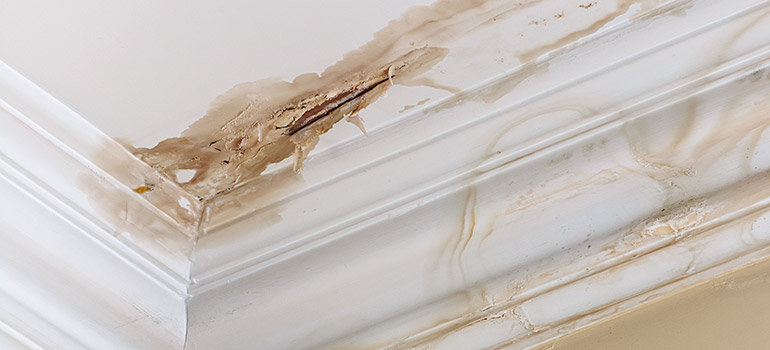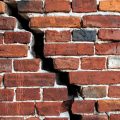
Water can find its way through pretty much anything, making it a serious threat, especially when it comes to your home. If you notice a strange discolouration or, worse, a sagging ceiling, then you can be certain that water is leaking into your home. It is essential to take action immediately before your furniture or property gets damaged further.
What’s causing the water damage on your ceiling
The damage to your ceiling will only worsen over time, so the most important thing to do is establish where the water is coming from. There are several possible sources:
- Plumbing issues – Pay attention where exactly the damage on your ceiling appears. If you know, it’s beneath a bathroom or kitchen. Then the leak is probably caused by a faulty element in the shower, drain, sink or toilet. If your home’s plumbing system is old, a corroded pipe could be also responsible for the damage.
- Damaged roof – Heavy rainfall and severe weather conditions can best reveal a problem with your home’s roofing system. If the water is already dripping from your ceiling and you notice that it’s brown and not clear, then chances are there’s a leak in your roof that needs to be checked right away.
What to do in case of a leaking ceiling
Plaster or drywall, a leaking ceiling is a serious matter, and you need to take measures right away to protect your property. Here is what you can do:
- Remove your belongings – Move furniture further away from the wet areas and try to absorb as much of the liquid as possible before it damages the flooring. Lay down towels and place buckets, and other containers suitable to collect the water dripping from the ceiling.
- Assess the damage – Thoroughly inspect the affected area and try to locate where the water is coming from. Drywall ceilings can absorb water, so there is a little chance of dripping unless there is major damage. That’s not the case with plaster, though, which tends to detain the water until it’s soaked up and then release it. If the latter happens, it is best to poke a small hole into the sagging ceiling to release the collected water. Make sure you have a bucket and that the floor is fully protected before you do it.
- Prepare the area for repairment – Now that you have the situation under control and, hopefully, the source of the problem fixed, you can move on to repairing the ceiling. Ensure you clean out the area, remove all water and excessive moisture to prevent mould growth, cover the floors with newspaper or plastic covers (whatever you have) to protect it, and provide good ventilation by opening the windows.
How to repair a water damaged plaster ceiling
What you will need:
- Putty knife
- Ladder
- Protective glasses
- Primer
- Joint compound
- Mud pan
- Sanding block
- Paint and brushes
- Clean cloth
- Eliminate all damaged pieces from the ceiling – Make sure the ceiling is dry before you start repairing. Begin by removing with the putty knife cracked paint and plaster that the water has damaged. The surface needs to be completely smooth for the patching.
- Fill up holes and cracks – When the area is completely clean, you might notice cracks and even holes. Mix the joint compound in the mud pan and fill those up. Leave to dry before moving forward.
- Cover up the surface – Add one coat of primer, then apply the joint compound with the putty knife. It needs approximately 10-15 minutes to harden, and then you can add another coat. Make sure the layers are thin, or it will take too long to dry.
- Sand the area – Once the compound is fully dry, put on your safety glasses and use the sanding block to remove any imperfections on the ceiling. Then, dampen the cloth and wipe it to remove the dust.
- Add another coat of primer – Make sure you cover up the whole area.
- Retouch with waterproof paint – Wait a little bit for the primer to dry completely, and then you can start painting until the repaired area blends with the rest of your ceiling. If you need tips on how to do it, you can check our Ceiling Painting: Learn from the Pros guide.
How to repair a water damaged drywall ceiling
Plasterboard is very porous and can easily absorb water. Still, a joint compound can fix the smaller damages in the form of cracks or holes. However, severe ones like softening or crumbling of the material and sagging of the ceiling will require cutting and installing new drywall sheets. Here is how to do it!
Additional things you will need:
- Drywall sheets
- Drywall saw
- Tape measure
- Plasterboard screws
- Mesh tape
- Utility knife
- Cordless drill
- Taping knife
- Plywood strips
- Ceiling paint
- Clean out the area – Remove any damaged pieces that are hanging from the ceiling.
- Decide how much to cut out – To make things easier you can measure and draw to have a clear view. Use the drywall saw to cut all the damaged plaster out.
- Cut the plywood strips – Next, you need to measure the size of the hole and cut the plywood strips accordingly. Leave a little extra on both sides for stability.
- Attach the material to the strips – Place the former inside the hole and secure the drywall by driving the plasterboard screws through it into the wood with the drill.
- Add the new plasterboard – Carefully measure the hole and, based on that, cut the new drywall piece from the sheet. Attach it with the screws to the wood, as well.
- Cover with the joint compound – Mix the joined compound, also known as mud. Apply some on the joined areas with the putty knife, stroking forward and backwards. Cover with the drywall mesh tape. Smooth it out with the knife. Finally, apply the mud over the whole area using the taping knife.
- Sand, reapply and paint – Let dry, sand the area and then reapply. Once the area is completely smooth and dry, you can move on to painting.
Costs of repairing a water damaged ceiling
Every project is different, so there are a lot of variables to take into consideration. Several main factors play a role in determining how much you will have to spend on repairing your ceiling. Such as:
- The amount of damage – Milder damages can be fixed in a few hours and won’t require that much labour, while tasks like replacing drywall sheets are more complex and extensive.
- The time that the professionals will need to fix the ceiling – Since a handyman service is often charged by the hour, time is a crucial factor in the final price estimation.
- The materials that will be required for the job – These may be provided by you or included in the cost of the service when the professionals supply them.
- Additional tasks that you may require – Things like cornice installation could be an extra charge.
As you can see, repairing a water damaged ceiling is no easy job, and many things could influence the pricing. For certain, though, one thing is that such a task requires a level of expertise to assess the situation correctly and select the most suitable approach.
Fantastic handyman professionals are operating in all major cities of Australia, and they have solid experience in patching holes on ceilings, plastering and cornice replacement. The price for repairing a ceiling is charged per hour, starting from $55. There is a minimum charge of $135 where you are entitled to 2 hours of work, which could be sufficient to fix smaller damages on your ceiling.
What to expect from a professional service
- More serious cases definitely require an inspection from our specialist before we can tell you how much it will cost, while minor jobs can be quoted over the phone.
- The professional handymen will thoroughly inspect the area and make a plan of action.
- They will provide all the necessary equipment for the job. You can either provide the required materials, or the specialist can take care of that.
- The Fantastic handyman will replaster and fix any small and large damaged areas on your ceiling in full. Wall repairing is also part of their expertise so that they can take care of those, additionally.
- Full repainting of the affected ceiling area will be done to erase the traces of the water damage completely.
Don't postpone repairing water damages in your home
Hire a reliable handyman
You can book our handyman services in Melbourne, Sydney, Brisbane and Perth!


